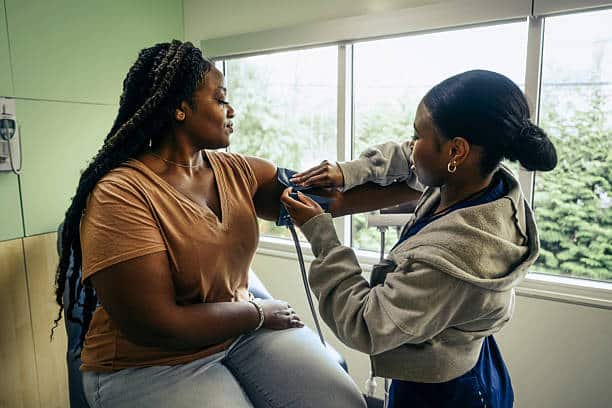
When Dr. Mark T. Loafman, MD, MPH talks about heart health, he doesn’t start with numbers—he starts with names. As a physician and public health leader at Cook County Health, one of the nation’s largest public health systems, Dr. Loafman has spent decades caring for Chicago families in safety-net hospitals—delivering babies, treating parents, and now caring for their grown children.
Over the years, he’s watched too many lives end too early from preventable diseases like heart failure. So when a new study revealed that Black Americans are developing heart failure nearly 14 years earlier than white Americans, Dr. Loafman wasn’t surprised. For him, the data simply echoed what he’s seen for decades: many Americans’ hearts are aging faster than they should—and for Black Americans, the clock starts ticking far too soon.
“I’ve unfortunately seen far too many of those folks suffer and die younger than they should—not at all due to bad luck, but to heart disease and other complications that are penalties because of their ethnicity and their geography. I see this firsthand,” Dr. Loafman tells BlackDoctor.
The “Perfect Storm” That Ages Your Heart Prematurely
Cardiovascular disease (CVD), which includes heart failure, heart attack, kidney failure, and stroke, is the end result of what Dr. Loafman calls a “perfect storm.” This storm accelerates the premature aging and damage of your arteries, a process called atherosclerosis (the plugging up of vessels). The three organs that take the brunt of this cumulative damage are the heart, kidneys, and brain.
The premature aging of your heart and vessels is not a result of a single factor but a combination of layered risks that work together destructively, starting in childhood.
1. The Burden of Toxic Stress
The psychological and physiological toll of toxic stress is a foundational factor.
“Most kids today in America would say they’re stressed, but that’s different from the level of toxic stress that happens when a parent is dead or incarcerated, or when a child witnesses trauma. These are well-known insults that happen,” Dr. Loafman says.
These Adverse Childhood Experiences (ACEs) launch an inflammatory process that directly leads to the premature aging of blood vessels. For families with sufficient resources and support, the impact of a bad experience can often be mitigated.
However, “Without that mitigation and support, it sets the stage for this,” Dr. Loafman explains.
He shares a devastating example: “I had a patient who had a stroke when she was 43—a classic stroke you’d expect to happen in somebody 80. When we went back over her social history, she had multiple Adverse Childhood Events and lots of factors that contributed. She had almost all of the things I talked about that could be socially driven risk factors, and we didn’t have a treatment for that other than trying to be supportive for her.”
2. Chronic Environmental and Dietary Insults
Daily life in underserved communities can layer on more risk, often restricting choices essential for health:
- Food Deserts and Nutrition: Dietary habits are often restricted by what is available and affordable. “People generally have access to enough food, but not necessarily healthy food,” Dr. Loafman says. He stresses that healthy, anti-inflammatory foods (like the Mediterranean diet) “takes resources; it requires access to a Whole Foods or a garden.” For many, the available food supply becomes a “chronic, daily, somewhat toxic exposure.”
- Air Quality: Chronic exposure to air pollution is more prevalent in urban, underserved areas. This is another environmental insult that contributes to cardiovascular injury without the protective influences that might buffer it in other communities.
RELATED: A Cardiologist Explains: Why Heart Disease Hits Black Communities Harder
3. The Damage from “Silent Killers”
Several medical conditions are widespread in the Black community, often driven by a combination of genetics and environment, and they cause severe internal damage without immediate symptoms.
- Hypertension (High Blood Pressure): This is the silent killer. Dr. Loafman notes that about half the public doesn’t know they have hypertension. “They don’t feel anything, but every day, every time their heart beats, the higher number is pounding away, causing strain on the heart and strain on the blood vessels—and that also is piling on and contributing to it.”
- Diabetes and Pre-Diabetes: High blood sugar and insulin levels act as pro-inflammatory hormones, promoting atherosclerosis and other complications. This damage is often a “smoldering insult” that builds up over years before diagnosis.
- High Cholesterol (Lipid Disorder): High levels of “bad cholesterols” are often genetically influenced and directly cause the artery damage of atherosclerosis. Without diet and lifestyle changes to mitigate them, these conditions compound the risk factors.

The Systemic Barriers to Prevention
Even when patients are motivated, the current U.S. healthcare system often fails the very communities that need it most. Primary care should be the foundation of prevention, but it’s often fragmented and underfunded.
“In reality, primary care in the U.S. is structured as a short business model; it’s not really designed to be available, and you don’t have a lot of time with the provider.”
This results in a major disparity in care effectiveness. In well-served communities, Dr. Loafman estimates 50 to 60 percent of patients meet their health goals; however, in minority communities, that number drops to only about 30 percent.
- Crisis Care Focus: Patients are forced to use the Emergency Room or urgent care for immediate, acute problems—a sore throat or a back injury—rather than engaging in the long-term, scheduled relationship necessary for preventive care.
“It’s ironic that the population that both needs really high-performing primary care that addresses the social determinants of health happens to be the least likely to get it. And that’s the frustrating perfect storm—the perfect storm of both risk factors and lack of access and inability to engage in mitigating things that let the rest of us live to be 80 or so.”
Beyond Simple Advice
Dr. Loafman knows that simply telling patients to “eat better” or “exercise more” is often useless because the resources are inaccessible. He recounts the story of a family he treated who owned a corner store, making their living by selling chips and sugary drinks. Their own children, consuming these foods daily, developed obesity.
“How do you tell them to change,” Dr. Loafman asks, “when their survival depends on selling the very things making them sick?”
He understands the difficulty of integrating healthy habits while managing demanding jobs, family needs, and safety concerns. “A lot of what I do to protect my health is really hard for me; it’s almost impossible for my patients to get at it,” he notes.
RELATED: ‘The Scariest Year of My Life’: How I Survived Heart Failure and a Stroke

A Call to Action: Reframe the Conversation
The crucial takeaway is both sobering and empowering: most cases of heart failure, kidney disease, and their complications are preventable. The tools exist, but the commitment to apply them must come from both the individual and the system.
Dr. Loafman calls for a fundamental reframe of the conversation, viewing CVD in Black America not as a medical issue alone, but as a consequence of structural racism.
“This clearly isn’t genetic? It’s not willpower. It’s structural racism; it’s built into the system,” he says.
For you, the patient, this reframing is key to reclaiming control. It’s not about being punished for your blood pressure or weight; it’s about a fight for your full life.
“It’s about taking control, protecting your health, and getting to live the full 90 years you’re entitled to. We can’t let a racist system continue to cut lives short,” Dr. Loafman adds.
Your Path Forward
- Start Early: Prevention must begin in childhood. If you are a parent, focus on mitigating the effects of stress and environmental factors.
- Know Your Numbers: Get screened for high blood pressure, diabetes, and high cholesterol. If you have these conditions, work with your doctor to develop a goal-directed therapy plan.
- Focus on Mitigation: While lifestyle changes are hard, they are essential. This means managing stress, getting conditions to goal (monitoring blood pressure and sugar), managing weight, adopting an anti-inflammatory diet (Mediterranean style), and getting regular exercise.
- Advocate for Systemic Change: The fight for better health requires better access: stronger primary care, community resources for healthy food and exercise, and policies that address the social determinants of health.
Dr. Loafman is hopeful that by recognizing and naming these systemic barriers, a powerful movement will emerge to ensure that every American has the chance to live a long, full life.









